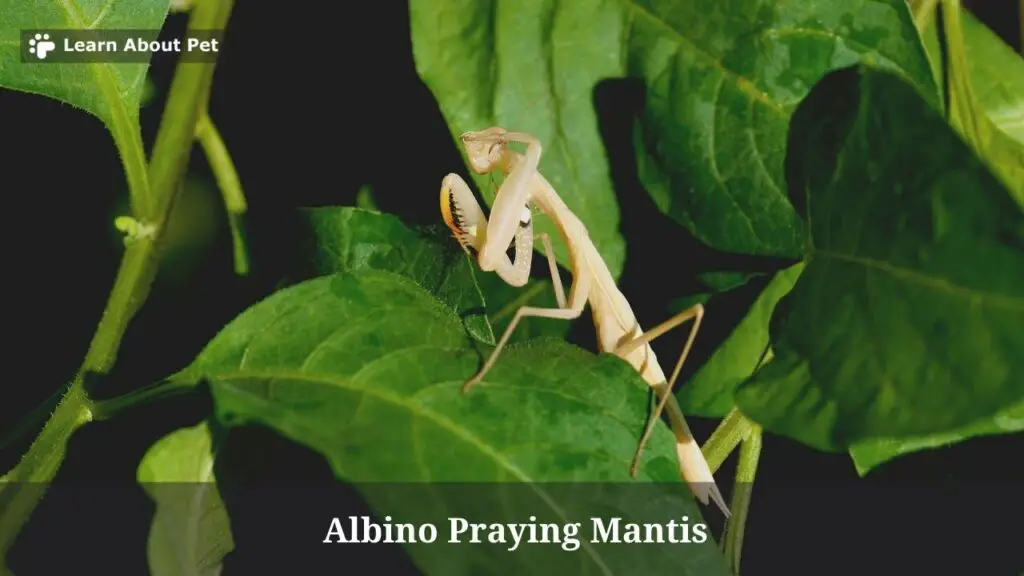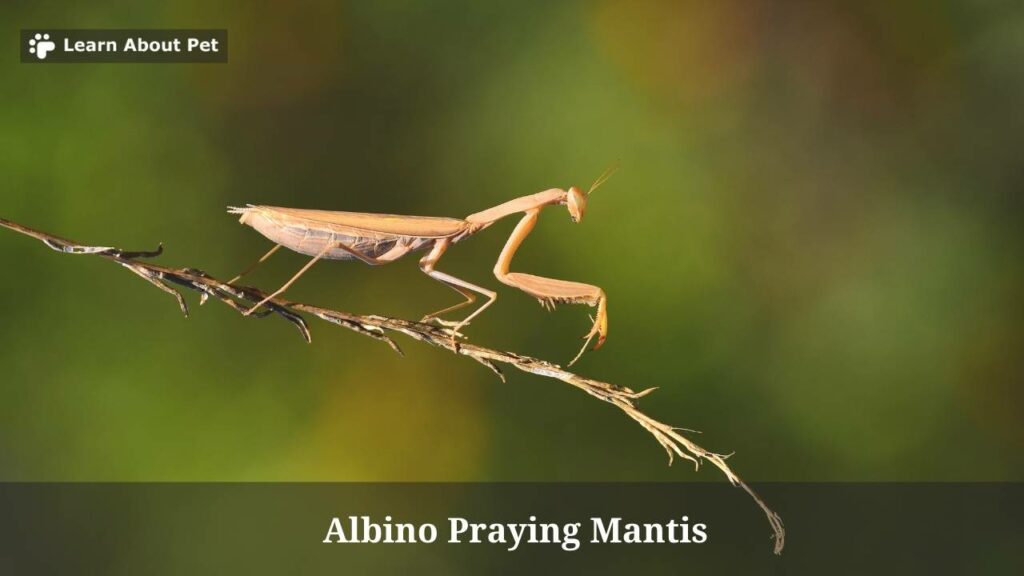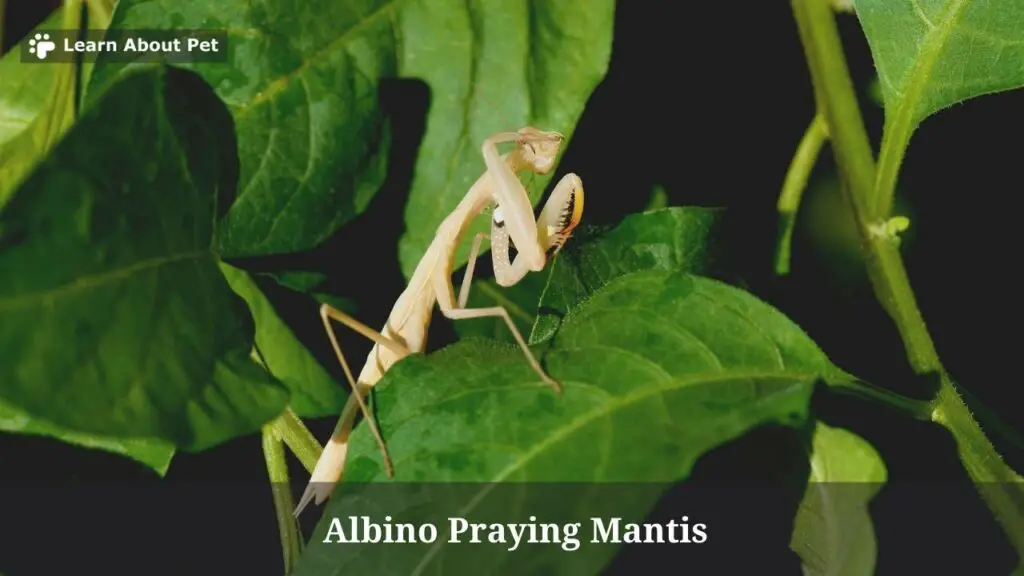Lately, there has been lots of interest on albino praying mantises. We see many people seeking to know if such albino mantises really exist (or if they are a myth). If they exist, people seek to know how they actually look and how much they are worth. This article answers all those questions.
The commonest colors for praying mantis are green and brown. Sometimes though, one encounters a white/pale praying mantis. It is this sort of praying mantis that people refer to as ‘albino’.
Thus what people refer to as an albino praying mantis is simply one whose color is pale or white. Usually, this will be a mantis that has molted recently. With time, its color darkens. For the time being though (shortly after the molt), it looks like an ‘albino’.
In day to day parlance, what makes a praying mantis albino is the presence of white color (or paleness) on its body. So for most people, what makes a praying mantis albino is that sort of coloration: regardless of the mantis’ species or subspecies.

Thus it is pretty much any white or cream pale praying mantis that we refer to as an ‘albino’. If you research on what is an albino praying mantis, you will see that it is one whose color is white/pale.
Alternatively, you can research on what kind of praying mantis is white. Most sources will tell that such white ones are what we refer to as albino praying mantises.
There are those who may point you to the species we refer to as Stagmomantis limbata as the ‘albino mantis’. But that species is usually brown or green in color: only turning white/pale after molting.
We can’t box all white/pale praying mantises into any one species.
Are There Albino Praying Mantis?
There are praying mantis that seem to have no body color. They are very pale (or otherwise appear white). Those are the ones that we refer to as albino praying mantises.
In the strict scientific sense though, we wouldn’t talk of there being albino praying mantises.
For an organism to be truly albino, it needs to have melanocytes on its dermis. And those melanocytes need to be incapable of producing melanin.
Praying mantises of course have no dermis. Mantises rely on exoskeletons. Therefore we can’t talk of praying mantis that are unable to produce melanin – and which are therefore ‘albino’ in the strict sense of the word.
Nonetheless, there are praying mantis that appear white or pale in color. Those are the ones that we colloquially refer to as being albino mantises.
How Do The Albino Praying Mantises Look?
The albino praying mantises are very pale – pretty much white in color. Thus what you find is a praying mantis white albino.
It may turn out to be a small white praying mantis. Because of its whiteness or paleness, it is referred to as an ‘albino’.
It may also turn out to be a big white praying mantis. Then on account of its whiteness or paleness, it is referred to as an ‘albino’.
Remember, the ‘albino’ in question here is typically simply an ordinary mantis that has recently undergone molting. With time, it darkens. So the albino status is temporary.
You are unlikely to find a praying mantis that is permanently white/pale – that is, a truly albino mantis.
Are Albino Praying Mantis Rare?
So far, we have said that what people refer to as an albino mantis is simply one that has recently molted. After molting, it acquires white or pale color, which gives it an albino look.
So it is basically a white mantis. The question then becomes, is a white praying mantis rare? Or, more generally, are albino praying mantis’ rare?
And the answer is largely ‘no’. All mantises turn somewhat white soon after molting. But they darken with time.
Of course, based on your interactions with mantises, ever encountering a white/albino mantis (one that has just come out of a molt) may be a rare occurrence.
But people who keep praying mantises as pets soon come to discover that this phenomenon, of the mantises turning white/pale after molting (then darkening with time), is quite common.
Then again, molting is more common in young and fast growing mantises. Consequently, chances of encountering an apparently albino baby praying mantis are higher than those of finding an adult albino mantis.
The reason for such a white praying mantis baby being easier to encounter is in molting frequency. Molting happens more frequently in baby mantises.

Are Albino Praying Mantises Poisonous
We have said that what people refer to as ‘albino’ praying mantis are simply the white/pale ones that have recently molted. Such recent molting is really what makes a praying mantis albino (in terms of appearance).
Nonetheless, you may still find people asking, are white praying mantis poisonous? And the answer is ‘no’. Like all other praying mantises, they are not venomous.
These are just regular mantises that have recently molted, hence their white/pale color. In any event, no mantises ever are known to be poisonous.
What Does It Mean When You See An Albino Praying Mantis?
For people who don’t keep praying mantises as pets, encountering a white/albino mantis (simply one that has recently molted) can be a rare occurrence.
As with all rare occurrences, people try to attribute special meaning to it, and to draw symbolism from it.
And that becomes the basis for the questions on albino praying mantis symbolism: with queries like, what does albino praying mantis mean?
Upon encountering an albino praying mantis in my yard, I would also have such questions: at least subconsciously.
Or if I keep a praying mantis pet, and I suddenly find it white, I would have questions. The most basic of those would be, why is my praying mantis white? Does it have any mystical significance…
So there is really that sort of yearning for an albino praying mantis meaning at a deeper level.
The true position is this: it is upon you to figure out what meaning you will ascribe to the encounter with an albino mantis.
Some may make albino praying mantis good luck associations. And those make sense, as randomly encountering a mantis that has recently molted (and is hence white/pale) is quite rare…
Thus it is upon you to figure out what to make of your encounter with an albino mantis. Just keep it in mind that this is just a regular mantis that has recently molted.
How Much Is An Albino Praying Mantis Worth?
If you ever find someone offering an albino praying mantis for sale, then the price would typically be in the $6 to $35 range.
That is what the people who sell praying mantises that are to be kept as pets sell them for.
There is really no special albino praying mantis price. The normal price for praying mantises applies here: typically $6 to $35.
But while buying the mantis, don’t expect that it will remain forever white/pale. Remember, it is just white because it has recently molted. With time, it is bound to darken: typically acquiring a green or brown color.
For most of the albino praying mantis lifespan, it will usually be in its regular color. That is likely to be either green or brown. But whenever it molts, any praying mantis is likely to turn white/pale for a while, before darkening again.
Final Verdict – Albino Praying Mantis
Praying mantises whose color is pale or white are commonly regarded as being ‘albino’ mantises.
In actual fact though, the supposed albino mantises are simply those that have molted recently. After molting, all albinos acquire a pale or white color – giving them an albino appearance.
Strictly speaking, a praying mantis can’t be a true albino. True albinism is associated with lack of melanin production in the dermis. But these insects have exoskeletons, not dermises: meaning they can’t be true albinos.
Nonetheless, someone who encounters a recently molten (white/pale) mantis may be inclined to think that they have encountered an albino mantis.

Some even go as far as ascribing special symbolic meanings to such mantises.
If you are considering buying an albino mantis you have encountered somewhere, do so from an informed perspective. Know that what you perceive as an ‘albino’ mantis is simply likely to be a recently molten one.
In due course, the white/pale ‘albino’ mantis is bound to darken, acquiring its regular color.
As a pet lover, make sure to learn about pet more and give your pet mantis a good and comfortable life!

Welcome to Learn About Pet. My name is Rajkumar Ravichandran and I love all pets, travel, and amazing food. I write about my passion and personal experience caring for multiple pets in this blog! ❤️
Post Disclaimer
DISCLAIMER: THIS BLOG OR WEBSITE, "Learn About Pet", DOES NOT PROVIDE YOU WITH MEDICAL ADVICE AND IS NOT A SUBSTITUTE FOR MEDICAL ADVICE. ALWAYS GET IN TOUCH WITH YOUR PERSONAL VETERINARIAN AND USE INFORMATION HERE AS GENERAL ADVICE.
The information, including but not limited to, text, graphics, images and other material contained on this website are for informational purposes only. No material on this site is intended to be a substitute for professional veterinary advice, food recommendation, diagnosis, or treatment. Always seek the advice of your veterinarian or other qualified health care provider with any questions you may have regarding a medical condition or for pet food related questions.







